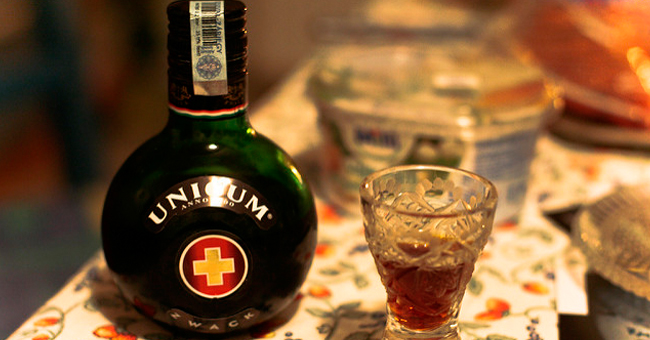Many a modern bar team professes its love for bitters. But Amor y Amargo, a bar in Manhattan’s East Village, truly walks the walk: the place has about 250 tincture (non-potable) bitters and 110 potable bitters on the shelves at any given time. At its helm is Sother Teague, the bar’s beverage director and a walking encyclopedia of all things bitters-related. Teague’s enthusiasm for all things amaro is contagious, and it’s clear that he knows his stuff all the way from Aperol to Zucca. So, we asked him to lead us on a guided tasting of six interesting amari: Amaro Montenegro, Vecchio del Capo, Cynar, Amaro dell’Erborista, Unicum and Jägermeister. Here are some of the highlights we learned along the way.
1. We’re hardwired to dislike bitter flavors.
“We’re born with a sweet palate; we come out of the womb looking for sugar because it’s calorically dense and probably not poisonous,” says Teague. “It’s good for our growth and survival as a species.” But bitterness is the only one of the five palate flavors that’s an acquired taste, because our brain are conditioned to perceive it as poison. “Even if we put it in our mouth and our mouth says, I think I like this, within a nanosecond the brain says, ‘no you don’t, that’s poison,’” Teague explains. Hence why amari requires a delicate touch when introducing novices.
2. When it comes to amari, there are no rules.
Unlike the way that European vermouth, for example, has to adhere to certain standards, this category has few requirements other than the bittersweet profile. “Amaro has become an umbrella term much in the same way that not all cotton swabs are Q-Tips,” says Teague. This anything-goes approach can make it tough to compare one amaro to the next. “As spirits professionals, we often think about things like bourbon, where you can compare and contrast one bourbon to the next because there’s a set of rules that define what bourbon is,” he says. “With amaro, there are no rules — the entire definition of amaro is ‘bittersweet liqueur.’ They can go in any direction they want to go.” This free-for-all approach makes it a bit tough to stack individual amari up against one another, in the apples-and-oranges way.
3. The range of flavor profiles — and, by default, the potential uses in a cocktail — is limitless.
Our first tasting sample, Montenegro, clocked in at a mere 23%, which makes it a very sessionable amaro — and, according to Teague, a handy ingredient for cocktails in a bar like his, where there is no juice. “This is one we reach for when we want a drink to be juicy and light; it’s a great substitute for juice,” he says. “It stirs into drinks really well and makes them lighter and brighter, but still brings a nice bitterness.” Plus, he adds, “it’s one of my favorites.” On the other end of the spectrum, Amaro Dell’Erborista’s smoky notes (which come from Varnelli’s open-pot distilling method) make it an ideal sidekick to Scotch, either to add smoke to blended Scotches or to back up the smoke in peated whiskies.
4. Artichokes change the way you perceive sweetness.
Teague references Amy Stewart’s “The Drunken Botanist,” which explains that artichokes have the ability to temporarily suspend our perception of sweetness. “This is why sommeliers have a real bear of a time pairing a dish of artichokes with a wine, because your perception of sweetness is impaired, which means everything else is out of whack as well,” he says. Teague uses this as an opportunity to experiment. He cites a drink on the menu at Amor y Amargo called the CIA, which combines Cynar and Applejack with Punt e Mes, apple bitters, and a bit of water, served neat. “The apple brandy, sweet vermouth and apple bitters all come off as sort of sweet, and the Cynar sneaks in there and limits your ability to perceive that sweetness, so the drink then becomes richer, darker,” Teague explains. “I like to pair Cynar with sweeter spirits or ingredients because, again, you can get a lot of sweet ingredients there with different mouthfeels and different textures, and the drink comes off as a little more bitter.”
5. Cynar developed a higher-proof version of their formula just for bartenders.
Cynar also has a 70-proof that Sother helped test out. The higher-octane amaro, which was released last year, came about entirely because of the cocktail movement. “Their entire goal was to create a more solid structure for the product to stand forward in cocktails,” says Teague. “All these guys who’ve never been concerned with cocktails are now becoming excited because it’s a revenue stream for them, and a point of recognition.” The resulting juice is similar in profile to the original formula, but higher-proof — “they wanted to make something that would stand out in cocktails but they wanted the flavor to remain the same,” Teague explains. “It’s warmer in the chest and a bit lighter on the palate because the evaporation rate is faster with a higher ABV.”
6. Amor y Amargo hides the goods from customers until they’ve been thoroughly vetted.
When new bottles arrive at Amor, the staff places them on the shelf with the labels facing backwards because, says Teague, “we don’t experiment on our guests.” Instead of putting a new bottle straight on the shelves for customers eager to try something new, Teague and his team spend time with each new product to make sure it’s fully vetted. “I get two bottles of anything brand-new and we drink those two bottles amongst ourselves before we start testing it on other people,” he says. “Until we’re secure in it, we don’t serve it. My joking thing I always say about that is that there’s no way I could expect my staff or myself to make chicken soup if we’ve never eaten chicken.”
7. There isn’t really a good definition for what makes a fernet a fernet.
“Overwhelmingly, people — even industry professionals — will come into my bar where I have 11 fernets on the bar right now and they’ll say, oh, I didn’t even realize there was another Fernet,” says Teague. “I would liken that to someone coming in and thinking that Elijah Craig is the only bourbon.”
But what makes a fernet a fernet? “For a time, everyone had a consensus that they agreed on, but then we found that many fernets broke that, too,” says Teague. The consensus (which he still mostly abides by, for simplicity’s sake) is about beets. “Fernets use beet molasses as a sweetener, they use beet molasses as the original distillate, or they use a combination thereof,” says Teague. Admittedly, it isn’t perfect — and the vast range of variations in the fernet category make things even trickier. “I have fernets that range from highly mentholated from Fernet Branca to fernets with juicy mouthfeels full of baking spices, like Jelinek Fernet from the Czech Republic,” he says. “Then there’s the woody, dry, super viscous ones from Mexico from the Vallets. There’s Leatherbee from Chicago, which is really pointy and eucalyptus-y and sharp in your mouth.” It’s sort of a free-for-all, with the underlying understanding that most (but not all) of them utilize beets, somehow. It isn’t perfect, and as Teague says, that frustration simply comes down to “the inherent human desire to categorize things — and the impossibility of doing so in this particular arena.”
8. Flavors can be manipulated through temperatures.
Consider this scenario, via Teague: “if you’re in a meadow on a sunny afternoon and you pluck a rose, that rose will smell floral and herbaceous and bright and alive. If you then put it in your freezer for three hours, and you smell it again, there’s kind of nothing.” That’s because the volatility of aroma is compressed in cold temperatures. And since aroma is responsible for 90% of what we perceive as “flavor,” extreme cold will essentially erase spirits’ flavors almost entirely. Pair that with the fact that a shot of freezing-cold liquid will numb the tastebuds, and you’re further muting any potential nuance of flavor. “90% of its flavors are being erased by not having an aroma, the other 10% are definitely being interfered with because it’s so cold,” he says. But thanks to our brain equating bitter flavors with poison, bitterness will still come through, even in a freezing-cold shot of Jager. “So when you see that frat boy with his hat on backwards taking that ice-cold shot of Jagermeister, and he makes that terrible face, it’s because all he got was a big mouthful of bitter,” says Teague. “The system eliminated his ability to taste those 56 ingredients that they have, and it gets whittled down to just bitter.” Knowing the way that temperature can affect aroma — and, by extension, flavor — is crucial to anyone in the culinary or spirits professions, Teague says.
9. …but that doesn’t mean all cocktails should be served neat.
Just because cold temps make for more muted flavors doesn’t mean all drinks should be served room-temperature. “Dilution is great for cocktails,” Teague adds. “It opens up water-soluble esters, which release more aromatic compounds. Water also softens the mouthfeel and makes it less rich.”
10. Citrus is almost always a safe bet for garnishing amaro cocktails.
At Amor y Amargo, garnishes are kept simple. “The only garnish we use is citrus: grapefruit, orange, and lemon,” says Teague. “Most amari have a big burst of citrus in them, so it’s an easy go to back that up.” But, he adds, it’s simple to enhance the flavor of an individual amaro just by picking out some of the notes inherent to each bottle — a stick of cinnamon in the Del Capo; a bit of ginger with your Jagermeister.
11. The most aggressively bitter amaro Sother’s ever had is…
Elisir Novasalus, he says. That bit he mentioned before about all amari using sweeteners? “This one uses a sap from one of the trees where they get the bark to make the amaro,” he says. It’s technically not a sweetener, but it adds some inherent sweetness. “It is sharply bitter, powerfully drying to the palate,” says Teague. “This is by far the bitterest of all the potable bitters I carry at Amor y Amargo, and maybe that I’ve ever had in my life.” The wine-based amaro only clocks in at 16% ABV, but it is very dark, full of pine and juniper notes, and “wickedly bitter,” as he says.
12. Bitter is great, but what about salty?
We’ve talked through spirits and liqueurs that appeal to most of our palate, from sweet to bitter. But has anyone developed a liqueur that hits the salty notes? Yes, and unsurprisingly, Teague’s tried it: he cites an Icelandic amaro called Opal, and likens it to “salted mouthwash.” “It’s highly mentholated, very bright and refreshing in that way, but very salty,” he says. So salty that, when guests come in to Amor y Amargo and ask for a dirty martini (which isn’t something the bar can make since they don’t have olives or olive brine), Teague makes them a riff on a martini using that.
Check out the full tasting in the video below:




